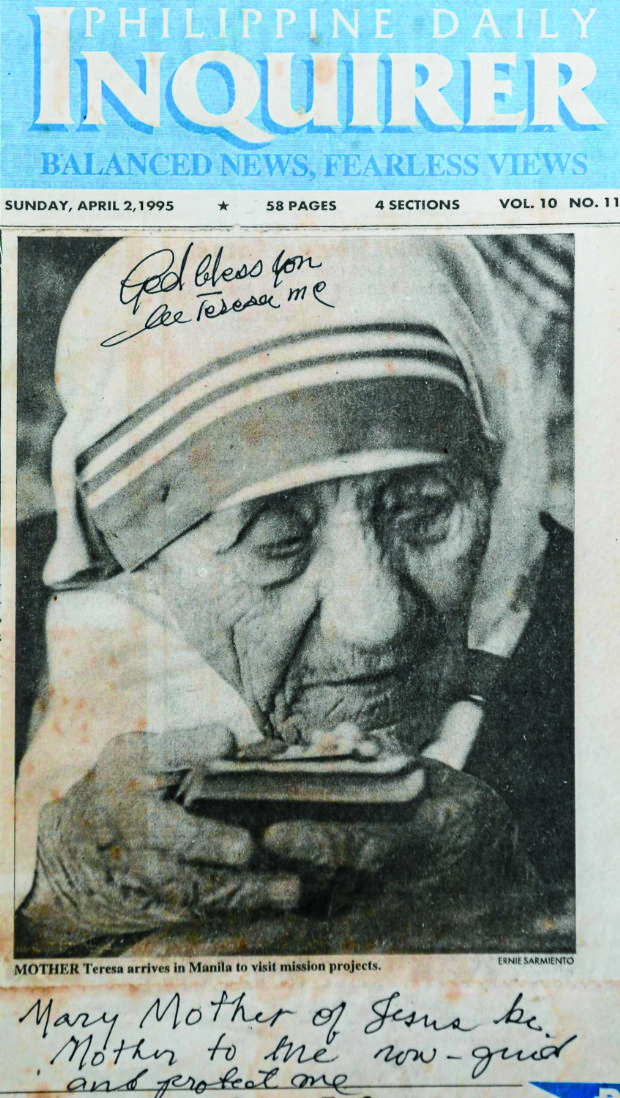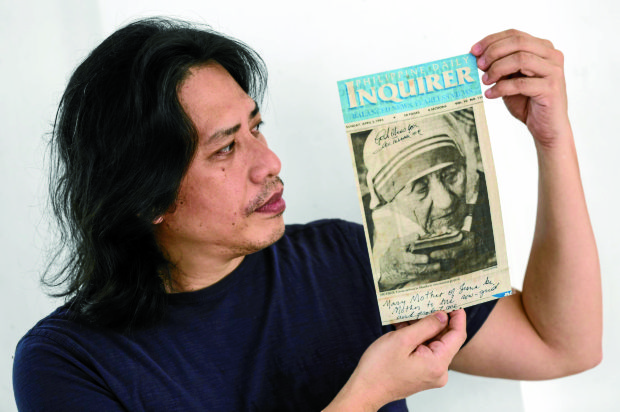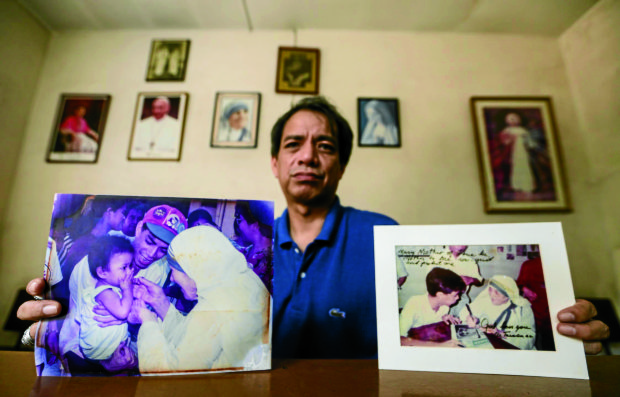Encounter with a saint: ‘She was a rock star’

The original print dated April 2, 1995 of the Inquirer page carrying Mother Teresa’s photo with a handwritten message from her for Alfonso Jose Cruz, who lined up to meet her and have this autographed. It is in the safekeeping of his friend and fellow stamp collector UP Fine Arts Prof. Marco Ruben Malto II. INQUIRER PHOTO/LYN RILLON
SHE HAD the habit of cupping a person’s face with her hands and bringing them to her lips to kiss. Her aura was gentle, her bearing modest, but she loomed larger than life.
“To me, she was like a rock star,” Alfonso Jose Cruz said of Mother Teresa of Kolkata, the “saint of the gutters,” who will be canonized by Pope Francis today, 19 years after her death.
In April 1995, Cruz, a buy-and-sell businessman from Malabon City, experienced the meeting of a lifetime when he, his wife Gina and their firstborn daughter Ma. Angelica were blessed by the founder of the Missionaries of Charity order.
It happened during Mother Teresa’s visit to the missionary house on Tayuman Street, Manila—the last of the handful of trips she made to the Philippines throughout her life. She succumbed to heart failure on Sept. 5, 1997.
The 49-year-old Cruz, who contracted polio as a child resulting in a withered leg, recalled being desperate to get the autograph of the 1979 Nobel Peace Prize winner as a keepsake—only he didn’t have a picture for her to sign.
Article continues after this advertisementSo he did the next best thing: He purchased the day’s issue of the Inquirer featuring a large black-and-white photograph of Mother Teresa on the front page. He handed the newspaper to her after he and his wife, who was carrying their daughter, managed to navigate through the thick crowds who had queued up to get the nun’s blessing inside a cramped office.
Article continues after this advertisementNun’s dedication
Glad to oblige, Mother Teresa wrote a dedication at the top of the page in a neat hand: “Mary Mother of Jesus be Mother to me now—guide and protect me.” She added another message, “God bless you,” and signed her name underneath.
Cruz’s friend, Father Ricardo Mallari, who had alerted his family to the nun’s visit, took pictures of the their meeting with Mother Teresa.
They were so excited they had the photos developed at a nearby shopping center on that very day. “There weren’t any digital cameras then. We all had to wait for the film to be developed,” Cruz said, chuckling.
By a stroke of serendipity, the Cruzes saw Mother Teresa again in the same venue the next day, on April 3. Cruz, who was only 25 then, showed her one of the pictures of her signing the Inquirer cover. “She went ‘oooh,’ like she was surprised to see our picture so soon,” he said. She also signed the photo.
He said the entire time he spent with Mother Teresa in the span of those two days lasted only about five minutes, but he was struck by her grace and humility.
‘Very humble, always smiling’
“Her voice was very soft, and I would just keep nodding my head whenever I didn’t catch what she was saying,” he said in Filipino. “She was very humble, and she was always smiling … She had no qualms hugging people,” he said.
He said it seemed strangely fitting that as someone who never met his own mother—she left him to his single dad—he would be able to meet such a giant motherly figure in his lifetime.
“She had such a presence that any tall person would feel compelled to bow down to her,” Cruz said.

Collector and UP Fine Arts Prof. Marco Ruben Malto II with the original print dated April 2, 1995 of the Inquirer page carrying Mother Teresa’s photo with a handwritten message from her for Alfonso Jose Cruz, who lined up to meet her and have this autographed. INQUIRER PHOTO/LYN RILLON
Mother Teresa died only two years after that Manila visit. But the memory of the Cruzes’ encounter is preserved in the signed April 2, 1995 Inquirer issue and the photographs along with it.
The memorabilia are now in the safekeeping of Cruz’s long-time friend, Marco Ruben Malto II, a fine arts professor at the University of the Philippines and his fellow stamp collector. It was Malto who first notified the Inquirer about the existence of the photos and the signed newspaper issue in an email.
“Our neighborhood in Malabon always gets flooded, so I got concerned that the pictures and the Inquirer paper might be ruined,” said Cruz, now a father of five.
The family, however, keeps framed copies of the photographs in their tiny apartment unit to show to friends and visitors.
His daughter Ma. Angelica, who was only 9 months old at the time, said she could no longer remember the meeting but she found the picture of her being held by Mother Teresa to be a source of comfort.
“It was only in grade three or four when I saw the pictures. I was shocked because her name would often be mentioned in school, and I had no idea I’d met her before,” she said. “I felt very blessed because not many children experienced that.”
Now a mother of three at 22, she said she prayed to Mother Teresa when she gave birth to her first child four years ago.
“I asked for her help. I asked her for strength. Whenever I look at the picture, I feel happy, like I am being blessed. I am thankful. It’s like a miracle in a way because I was able to deliver my baby safely,” Ma. Angelica said.
Miraculous change
Did the Cruz family experience any miraculous change after their encounter with Mother Teresa?
Not in any obvious way, he said. Instead it changed his outlook about the world. Meeting the saint made him more sympathetic towards “the least, the last and the lost,” or the people Mother Teresa wanted most to help, he said.
Cruz said he didn’t need to experience any personal miracle to realize or understand Mother Teresa’s contributions to the world.
“Nobody else can do what she did. She served those suffering from AIDS or leprosy. She will bathe them and cut their hair and do her best to help them out,” he said. “That’s the miracle.”

Alfonso Jose Cruz showing his pictures with Mother Teresa at the Missionaries of Charity Formation House in Tondo, Manila. At left is with daughter Ma. Angelica and at right, a reproduced version of Mother Teresa autographing an April 2, 1995 Inquirer print copy. INQUIRER PHOTO/LYN RILLON
Started in the 1970s, Mother Teresa’s Missionaries of Charity has 18 houses now distributed all over the Philippines, including the two facilities in Tayuman that are right across each other.
One caters to 61 children while the other houses 80 elderly residents.
Visit to the facilities
During the Inquirer visit on Friday, most of the children were cavorting at a play area, bouncing around with balloons and toys. But those in wheelchairs sat quietly on the side, some of them connected to an intravenous drip.
There are 13 of these “permanent” residents, who are either “crippled, bedridden, brain-damaged or dying” in the center. “They will be here all their lives,” according to one of the sisters running the place. The nuns are barred by the order from being interviewed.
The same is true of the other facility, where many of the residents are advanced in years. “This is a place for dying people,” another nun said.
The two sisters differed when asked how they thought Mother Teresa’s sainthood would help their missionary work.
“I am not that overjoyed because she’s always been a saint to me. I don’t know [how this will help us]. She has always been helping us,” one said.
The other said she hoped Mother Teresa’s canonization would bring more of God’s grace.
Mother Teresa’s sainthood, she said, would mean a lot to the people they serve. “Look at all this,” she said, her hand motioning toward the hustle-and-bustle at the children’s home. “It’s a small seed that has grown into a tree.”